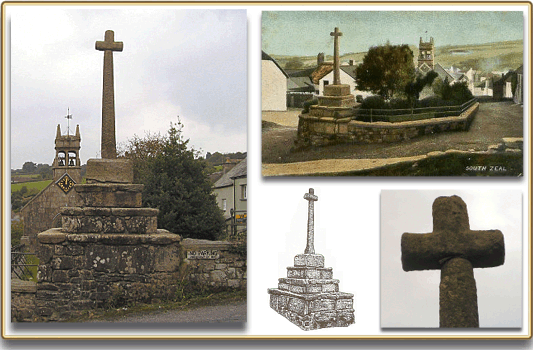
If you travel down the main street of South Zeal in a south easterly direction you will soon encounter a small. slender cross mounted upon three granite pedestals forming a type of pyramid. If anything the cross seems out of proportion with the pedestals insomuch as it’s too slender for its base. Nonetheless the cross makes for a picturesque feature as when viewed from a north westerly direction it has a fine moorland backdrop. William Crossing, (1987, p.127) describes the cross thus:
‘The base of the cross is a stone about three feet square and twenty inches in height, its upper edge being bevelled. The shaft is of an elegant tapering form, one foot square at the bottom, but a short distance from its foot the angles are chamfered, and it becomes octagonal. Just below the arms there is a kind of wide fillet running around it. The head and arms are not one with the shaft, but are fixed upon it.’
Without involving a rope and incurring the wrath of the locals it is impossible to measure the cross but the consensus of opinion is that it stands at around nine feet tall. When the base and pedestals are taken into consideration the put the entire height at around eighteen feet. English Heritage date the cross to around about the 1400s and Sandles, (1997, p.96) suggests that it would have been used as a preaching cross. As South Zeal was granted licence to hold a market and two fairs in 1299 the cross may well have also been used as a market cross?

As with many of the Dartmoor crosses there is a legend associated with the cross. The old story related how a local man from South Zeal was sailing from America to England when the ship sailed into the midst of a violent storm. Fearing for his life, the man prayed to God to deliver him safe from the ravages of the tempest and should he be shown such divine mercy he would re-erect the South Zeal cross on his return. The fortune man survived the storm and on arriving back in the village he immediately set to and restored the cross as he had promised. Page, (1895, p.86) adds a slight variant on the grateful deed insomuch as he relates how the man actually whitewashed the cross which I am sure would have gone down a storm with the locals. There is a striking similarity to this tale as of that attached to the origins of Brentor Church which was also built by a grateful sea voyager.
But as Crossing, (1987, p.127) informs us, that is not exactly how it happened. In 1838 one John Stanbury was sailing from America to England, just as the legend states, however there was no storm and the man made a peaceful crossing to these shores. Stanbury was a carpenter by trade and had immigrated from South Zeal to America, he had simply returned to the village for a short break, presumably to visit family and friends. During his stay he noticed the damaged cross and set to and repaired it, having completed the task he ‘signed’ his work by carving his initials and the date of completion on the cross base. That kind of lets the air out of the tyres somewhat, but the story doesn’t finish there. For some unknown reason the villagers did not appreciate his act of graffiti and immediately removed his carved name and date, the scars of which still can be seen today. Maybe there was some jealousy towards his immigration or perhaps they considered that such acts should only be noted by the Lord, nobody knows what caused the annoyance. It may well have even been because John Stanbury was a Roman Catholic and it was deemed unfit for such a person to meddle with the cross? Either way, John Stanbury was not a happy man and it is at this point that he did make a solemn promise and that should he ever be on English soil again he would never set foot in South Zeal again. Having gone back to America, John Stanbury once again travelled to England in 1862 and as promised he never went anywhere near the cross or the village, this time he spent his holiday in Hennock, a good thirteen miles away. Crossing, (1987, p.128) tells us that his information came from a descendant of Stanburys’ – one Mr. S. Westaway of South Zeal.

Crossing, W. 1987. The Stone Crosses of Dartmoor. Exeter: Devon Books.
Page, J. Ll. W. 1895. An Exploration of Dartmoor. London: Seeley and Co. Ltd.
Sandles, T. 1997. A Pilgrimage to Dartmoor’s Crosses. Liverton: Forest Publishing.
 Legendary Dartmoor The many aspects past and present of Dartmoor
Legendary Dartmoor The many aspects past and present of Dartmoor
